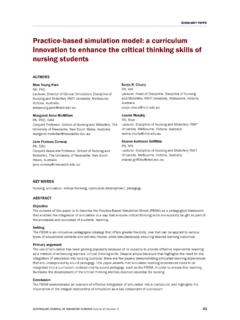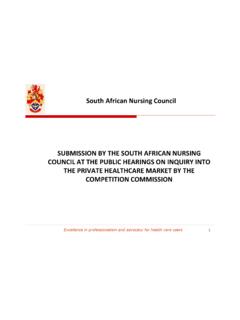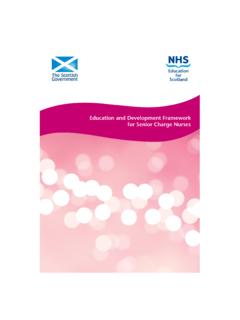Transcription of Strategy on Nursing Education, Training and …
1 Strategy on Nursing Education, Training and Practice2012/13 to 2016/175 April 2013 Outline of the PresentationPurposeThemesThemesObjective sObjectivesRecommendationsRecommendation sMembers of the Ministerial Task TeamMembers of the Ministerial Task TeamPurpose of the StrategyThe purpose of the Nursing education , Trainingand Practice Strategy is to develop, reconstructand revitalize the profession to ensure thatnursing and midwifery practitioners areequipped to address the disease burden andpopulation health needs in a revitalizedhealthcare system in South AfricaThemesThe challenges were examined under seven themes: Nursing education and Training ;Resources in Nursing ;Professional ethos and ethics;Governance, leadership, legislation and policy;Positive practice environments;Compensation, benefits and conditions of employment; andNursing human resources for of the StrategyTheobjectives are to: Promote and maintain a high standard and quality ofnursingand midwifery education and Training ; Enhance and maintain professionalism and professionalethosamongst members of the Nursing and midwifery professions; Promote and maintain an enabling, well-resourced andpositivepractice environment for Nursing and midwifery; Enable strong leadership at all levels of Nursing andmidwiferypractice.
2 Guide the production of sufficient numbers and theappropriatecategoriesofnursesrequired todeliverhealthcareservicesStrategic Priority 1 education and TrainingStrategicObjectivesTo develop a national Nursing education policyTo position Nursing education institutions inhighereducationTo implement a new Model for Clinical EducationandTrainingTo establish a national, uniform policy forstudentstatus and funding supportRecommendations: education and a national Nursing education policyPosition Nursing education and Training as a national competenceaccounting to the Director General of Health to address provincialinequalities, norms and standards, quality, clinical Training , studentstatus and fragmentation between NEIs and of CNO is instrumental in facilitating the task to developanational policy for Nursing education and.
3 education and Status of public collegesUrgent engagement between the national Department of Healthand the national Department of education and Training tofacilitate the process of incorporating public Nursing colleges andtheir programmes in higher education to enable them to continueto produce a task team to draft a public Nursing colleges an accreditation framework for NEIs and their clinicaltraining facilities using SANC and CHE criteria and the nationalcore : education and New Model for Clinical Nursing education and Training Initiate the Model for Clinical education and Trainingwithstructural support Re-establish clinical teaching departments at all NEIs orhospitalssupported by a coordinated system of preceptors andclinicalsupervisors.
4 Appoint a Working Group to champion the implementationthis model consisting of the Nursing education stakeholder(NES)group and two Human Resources representatives fromthenational and provincial Departments of Health. Incorporateclinicalmodelimplicationsinto currentlyproposedRecommendations: education and National policy for student status and funding support Award full student status to students in Nursing programmes. Develop a national funding model for Nursing students whichincludesstudent accommodation and uniforms. Funding support for all Nursing students should be provided bytheDepartment of Health. Students from countries outside South Africa must be funded bytheirrespective countries. Funding should be available for the minimum prescribed period fortheprogramme that students are enrolled for plus one additional yearwhichallow one year extension for the study programme.
5 Compel students to work for the state for same period as they werefundedfor,inclusiveofthecommunityser viceyear,toretaintheskillsfortheStrategi c Priority 2 Resources in nursingStrategicObjectivesTo develop a national Nursing portfolioTo develop and re-orient nurse educators toensuresufficient numbers of well-trained educatorsTo develop management competencies of, andreorient nurse managersRecommendations: Resources for Nurse Structural arrangements Appoint a dedicated person, reporting to the ChiefNursingOfficer within the NDoH to provide leadershipandstewardship for the Nursing education portfolio. The person should develop a National Plan to updateallnurse educators to meet requirements of thevariousnursing education of SANC requirements for registration as nurseeducator SANC should prioritise CPD for nurse educators.
6 The SANC requirements should be revised to take into account thescienceand art of teaching and graduating Nursing students. The core competencies required for prospective nurse educators shouldstipulated, to include inter alia: competencies in interpersonal relationships (including conflict resolution); clinical specialty or area of instruction; teaching and learning methodologies; supervision of theoretical learning and clinical practice; research methods, knowledge of technology in education ; ability to teach/mentor in a clinical environment (not just clinical competence); assessment methods; involvement in policy development and implementation; and leadership. Thepracticalcomponentshouldbeincreasedan dallnurseeducatorsshouldensureongoingcli nicalcompetenceDedicated fundingEar-marked funding should be available for a nurse educatorframework(similarto the Clinical Training Grant provided by theDepartmentEducationto universities)EachNEI should be allocated at least of their personnelbudgetnurseeducator should commence with the allocation of seed money tostartinnovativeprogrammes that target nurse educators.
7 An amountofmillionper province in 2013/14 financial year, expanding over theMTEF periodis sector bursaries should target number of resident universities that offer theAdvancedDiploma in Nursing EducationReviewthe Training of nurse educators, increasing the number of thosereceiveAdvanced Diploma in Nursing education from residentuniversitiesandreduce the number of nurse educators who obtain theirqualificationsthroughdistance integrated approach to the education of nurseeducatorsinvolvingeducation, service and Nursing experts in the curriculumplanningandpresentation, as well as the teaching and learning a specific recruitment and retentionstrategy fornurseeducatorsReviewthe career path of nurse promotionImplementan open and transparent merit-based promotionsystemfornursing management ProgrammeEmergingmanagers should be identified and allocated mentorsfromexperiencednurses of a senior rank who are respected and keenteachand for different levelsThereshould be recognition of the different levels ofnursingcompetencies,depending on whether it is an executivenursingmanager,anareanursingman ageroraunit/PHCfacilitynursing9 Review of the content of Nursing managementcoursesand the teaching methodsCompetenciesfor different levels of Nursing managementshouldbedefined.
8 And should include competencies in humanresources,caremanagement, quality/ patient/ forumsSetup Managers Forums at district or sub-provincial levelwheremanagersfrom both public and private sector can sharesuccessesandchallenges and learn from each other. These forumsshouldbeallocated resources and formally access to education and trainingAccess to education and Training programmes forclinicalspecialisation must be made available to enablepractitionersto enrol and complete programmes. This includestheprovision of study leave and financial career pathingTo retain specialist nurses, career pathing must be createdensure that practitioners have equal opportunity to remainclinical practice with Masters and PhD degrees. Thisrequiresthe negotiation for positions for clinical Priority 3.
9 Professional EthosStrategic ObjectivesTo implement a comprehensive programme to restore ethicsand respect in nursingTo promote the Nursing profession at school level to attract agood cadre of nursesTo mainstream ethics in basic and post basic Nursing trainingTo promote collaborative partnerships to unify Comprehensive programmeImplementa comprehensive programme to reinstate theprofessionalethosin the profession, to market the profession positively as a careerchoiceto potential recruits for Nursing proposed programme on Nursing and midwiferypractice,nursingeducation and Training , Nursing associations and Promote Nursing as a career of choiceFocusthe implementation of the proposed programme on bothcurrentnursesand prospective nurses or recruits into students through NEIs using SANC minimumrequirements.
10 Evaluate prospective students against ethics in Nursing education and trainingInclude professional and work ethics as compulsory components of in-service education and CPD programmes for all levels of education andtraining and practice of Nursing and ethics, innovative teaching, group studies and electronic mediain the development and reorientation of collaborative partnerships to unify the professionStrengthen links between societies, organisations and NGOs for humancaring to strengthen their the role of professional organisations and employers in assistingnurses to work and coordinate the professional associations which give theprofessional a sense of belonging and enhance motivation andGovernance, Leadership, Regulation and PolicyStrategic objectives To promote the effectiveness of SANC To promote regulation of community health workers To promote institutional governance and leadershipRegulation and Institutional Governance and Leadership Nurses must comply with the National Core Standards in terms of leadership andgovernance.








